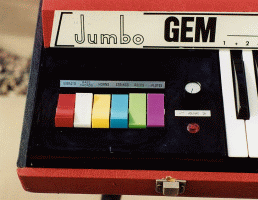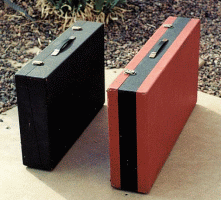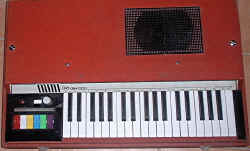GEM
Now known as GeneralMusic, GEM sold quite an impressive array of combo organs, among other keyboard instruments. They also marketed console organs under the Galanti name (GeneralMusic's current chairman is Matteo Galanti - perhaps the founder?). GEM stands for "Galanti Electro Musical". GeneralMusic bought out Elka in the early 1990's (I got most of this company info from MitaTechs). I've never seen a Galanti, but did hear from an owner of one who described it as "bright blue and really sick sounding".
| Model P | Jumbo | Jumbo 61 | Mini |
| Mini-Deluxe | Gemini | Caravan | Dakota |
| Europa | Intercontinental | S49 | S61 |
| Rodeo 37 | Joker 61 | Riviera | Challenger |
| Imperial |
The first few models listed here all appear to have virtually the same features, which are almost identical to those of the Vox Jaguar. Unlike the Jaguar, however, many(most? all?) of these have only a single "footage" available, unlike the Jaguar, which provides different mixtures of 16', 8' and 4' at various parts of the keyboard (see "Jaguar" in the Vox section). The Bass Chords feature, however, does seem to operate on the Gem's exactly like it does on the Jaguar, adding polyphonic treble voices to the keys in the bass section, with the lowest key pressed sounding a bass note in as well. This is a rather unusual feature for combo organs, which leads me to suspect that the Gem's are somehow related to the Jaguar. Other than the fact that they're both Italian (like about 3/4 of all combo organs!) I don't know what that relationship is. The Jumbo, Mini, Mini-Deluxe and Gemini all seem to be especially close cousins, sharing the above traits, plus the straight, furniture-style legs, and a built-in amp with speaker on top.
Controls:
Here's a sample of the sound: Gem Organ.wav Not a bad sounding little organ, really.
Also see Sandro Oliva's GEM web page for some nice pictures of his Model P
And here's a neat advertising flyer I picked up on eBay. I don't know what date it's from:
The Model P also appeared under the "Briscoe" name. Never heard of them, but it's obviously a GEM with a different nameplate:
Apart from the "Briscoe" nameplate, and the ID badge, it's identical to the GEM Model P, stand and everything. The ID badge, (which is a bit fuzzy in the picture), places Briscoe Music in Vancouver, BC, and proclaims the model name to be "CHORD", no kidding, just "CHORD" (those crazy Canadians!). I guess they didn't feel like trying to top "Model P" (which wouldn't have taken much effort, anyway).
(Thanks to Lorne for the pictures)
Controls:
 |
 |
| Tabs - looks almost exactly like the Mini and one of the Gemini's | The Jumbo and Gemini packed and ready to go. The Jumbo looks like a slimmed-down Farfisa Compact, doesn't it? |
|
And here we see a slightly different version of the Jumbo. Aside from the "normal" color keys, and somewhat smaller speaker grille, it has an additional knob, for Vibrato Speed (thanks to Izzy for the pictures, and Frank for identifying the extra knob) |
Controls:
 |
Three, count-em, three whole octaves of combo organ bliss! Built-in amp and speaker! Multi-colored voice tabs, and lovely red tolex! Here's a short owner's impression: "This organ looks really cool because of the slim body and it has chrome legs. The best sound from it has to be the green tab which is reeds, sounds like the Farfisa." NEW(Photo courtesy of Sandro Oliva. See his GEM web page for more on the Mini as well as some excellent pictures of his Model P) |
Controls:
 |
I guess "Deluxe" means wood-grain (rather than that nasty old red tolex!) Otherwise, it looks very much like the Mini (above) and the Gemini (below).. |
Controls:(I'm not certain of these - I'm assuming they're the same as the Mini, Gemini and Jumbo)
 |
Looks like just another version of the Mini and Mini-Deluxe(above). Same 37 keys, same 6 tabs and two knobs, same built-in amp and speaker. This one was available with Red top/Black bottom, all Red, and Grey top/Dark Grey bottom (like the one shown). The oscillators on this organ have only one divider, so there are really only two octaves of each note available. When "Bass Chords" is switched off, the lowest octave plays "bass" notes, and is monophonic. The bass notes are lower, but are an octave higher than that found on most combo organs. When "Bass Chords" is on, the bass octave, in addition to bass notes, also plays the same notes as the next octave up (middle octave) |
Controls:
I'm going to assume that this is a GEM, even though there's no brand name designation anywhere to be found. My original description for it was limited to "with a veneer top". I don't even remember where I got that from, but there's that veneer top, so this must be it! Also, in Peter Forrest's "A-Z...", he describes a Gem Caravan as "Portable single manual (49-note) budget organ with amp/speaker)". Not to mention that the controls are virtually identical (in function, if not appearance) to the "Jumbo" and "Model P" (above).
The one shown here was found by Brad at Melbourne Music Once again, I won't even attempt to compete with his colorful description, which I lifted and edited (only slightly!) from his eBay auction:
"From the country that brought you Farfisa, Elka and Eko, comes yet another cheesy comestible....The Caravan! This refugee entrant in the Miss Beautiful Organ contest really does outcheese many of the other cheesemakers. Four octaves of sheer bliss.....not only a Vibrato On/Off rocker tab, but a Speed control as well!! Add to this a stunning array of user accessible controls.....rocker tabs for Brass, Strings, Reeds and Flutes....you can even use them all together!! WOWWEE!!!! And you thought that modern synths had versatility. There's also a Bass to Lower keyboard tab for those great walking Bass lines. On the right hand side of the keyboard are a line output and a headphone output. Unbelievably,it also has a small monitor amp and speaker built in, assuring the user of superb sound reproduction - as only a 5" speaker can do. So what does it sound like? Very similar to the Teisco/Rheem or Eko/Howard organs....CHEESY!!!!!!!"
What could I possibly add to that! I guess I could methodically list the controls, in my usual boring fashion:
Controls
Knobs: Vibrato Speed, On/Off Volume
Tabs: Vibrato, Bass Chords, Brass, Strings, Reeds, Flutes
From Peter Forrest's "A-Z":
Two-manual combo organ with bass pedals, reverb, tremolo and vibrato. Circa 1971-?
Original price: £365
From Peter Forrest's "A-Z":
Portable single-manual (37-note) ultra-budget organ with
amp/speaker. Circa 1971-?
Vibrato, tape recorder input and output socket
Original price: £62.50 , 1974 price: £79
From Peter Forrest's "A-Z":
Two-manual (upper 61-note C-C, lower 49-note C-C) combo organ. Mid 1970's
A large and heavy instrument, particularly deep front-to-back, with reverse-colour keys on the bottom 17-notes of the lower keyboard, 17-sliders, and no fewer than 51 chunky rocker switches.
Piano, clavichord and spinet sounds as well
17-note pedalboard
1974 price: £675
(Thanks to Frank G. for the great pictures!)
 |
Only 37 keys, 5 voices, and that dreaded rhythm unit, but a ewL portable little guy, eh? Nice colors on those tabs, too! |
Controls:
 |
 |
Thanks to Carlos for these pictures of the Joker 61. I have no more information on it at this time.
Now we're getting somewhere! Multiple footages in multiple voices, drawbars, tremolo, bass sustain, and percussion! And look at that collection of creamy colors! Enough to forgive the excess of wood-grain laminate, I suppose. If I'm interpreting the "Legato" tab correctly, it even has multiple-triggering percussion! Hey, Hammond - get a clue! (well, I'm probably about 45 years too late with THAT advice.)
NEW Normally, the bass section is restricted to just that - no switch to extend the treble section downward. But apparently when a set of bass pedals is plugged in, the bass keyboard section is automatically switched to do just that - neat! (thanks to A.W. for that tidbit).
It also has a separate Bass output jack, which can be handy. I think they must have taken the "Tremolo Upper" tab from the Imperial (below), since there's really no "upper" manual.
Controls:
Bass Voices: Subbass 16', Diapason 16', Gedeckt 8', Bourdon 8', Octave 4', Sustain
Effects(red): Reverb, Vibrato, Vibrato Full, Vib. Delay, Bass Drum Bass, Brushes
Knobs: Volume-Bass On/Off, Speed Trem-Vibr., Perc. Volume, Perc Time.
Treble Voices:
16' (black): Bourdon, Cello, Diapason
8' (white): String, Oboe, French Horn, Trumpet,
Flute, Clarinet
4' (green): Flute, Octave, Salicet
2-2/3'' (purple): Quint, Cimbel
2' (blue): Flute, Fifteenth
Percussion:
Effects (black): Perc. Coupler, Tremolo Upper, Legato
Voices (white): 16', 8', 4', 2-2/3', 2'
Drawbars: 16', 8', 4', 2-2'3, 2' (and one more I can't make out)
And now a nice collage of the controls:
Imperial I:
Controls:
Bass Tabs: SubBass 16', Diapason 16', Bourdon 8', Tibia 8', Sustain
Lower Tabs: Vibrato Off/On,
Reverb Off/On
8' (white): Tibia, Reed, Horn, Salicional, Dulciana
4' (green): Flute, Clarion, Octave
2' (blue): Flautino, Piccolo
Upper Tabs:
16' (black): Bourdon, Cello, Diapason
8' (white): String, Oboe, French Horn, Trumpet,
Flute, Clarinet
4' (green): Flute, Octave, Salicet
2-2/3'' (purple): Quint, Cimbel
2' (blue): Flute, Fifteenth
Percusson Tabs:
Off 1/Effect 2/Coupler 3, Tremolo Upper,
Legato, Perc 16', Perc 8', Perc 4', Perc 2-2/3', Perc 2'
Left of upper keyboard:
Red tabs: Bass Drum Bass Off/On, Brushes Bass
Off/On, Bass Drum Great Off/On, Vib Delay Off/On
Knobs: Vibrato Speed, Vibrato Depth,
Volume-Bass Off/On, Balance Lower/Upper
Right of upper keyboard: Per. Time, Perc. Volume
Right of lower keyboard:
Reverb Volume(knob)
Sustain: Short/Long, String 8', Celesta 8',
Carillon 8', Cembalo 8', Vibraharp 8'
 |
 |
| Note the "G"-shaped stand - same as on the Model P | A collage of the controls |
Imperial II:
 |
In typical GEM fashion, there were
at least two versions of the Imperial. The "Imperial I",
described above, and this one, which I'm going to call the
"Imperial II". It differs in the following ways:
|
Controls:
Bass Tabs: SubBass 16', Diapason 16', Bourdon 8', Tibia 8', Sustain
Lower Tabs: Vibrato Off/On, Vibrato Delay
8' (white):
Tibia, Reed, Horn, Salicional, Dulciana
4' (green): Flute, Clarion, Octave
2' (blue): Flautino, Piccolo
Upper Tabs:
16' (black): Bourdon, Cello, Diapason
8' (white): String, Oboe, French Horn, Trumpet,
Flute, Clarinet
4' (green): Flute, Octave, Salicet
2-2/3'' (purple): Quint, Cimbel
2' (blue): Flute, Fifteenth
Percusson Tabs:
Off 1/Effect 2/Coupler 3, Tremolo, Legato, Perc
16', Perc 8', Perc 4', Perc 2-2/3', Perc 2'
Black Drawbars: Ped. Vol, Vibr. Speed, Vibr. Vol., Perc. Time, Perc. Vol., Reverb, Balance
White Drawbars: 16', 8', 4', 2-2/3', 2'
Right of lower keyboard:
Sustain: Short/Long, String 8',
Celesta 8', Carillon 8', Cembalo 8', Vibraharp 8'

I bought the one pictured here, and can now expound upon it at greater length:
Music stand: It came with a plexiglass music stand that says "Imperial" on it. I'll try to get a picture up soon. I have no idea how it survived, since it must be removed to close the lid, and there's no proper place to store it. Alas, the legs didn't fare as well, and have gone on to Combo Organ Leg Heaven.
Voice tabs: Quite a varied pallette indeed. I've only begun to explore them, but most do provide their own distinct sound, and, as you can see, there's a BUNCH of them!
Voice drawbars: These are separate and independent voices from the tabs, and, as explained later, are not subject to some of the special effects that operate on the tab voices. The drawbars are not as flutelike as you might expect, and are not simply different ranks of the same voice (like a Hammond). The 16' and 8' drawbars are relatively "flutey", and are different ranks of the same voice. The 4', 2-2/3' and 2' drawbars are ranks of a different, brighter voice, not as flutelike.
Reverb: Actually built-in (not just a switch to control an external reverb, like a Compact Duo or G101), and sounds pretty good. The Reverb drawbar performs both the On/Off and Volume functions.
Bass voices: Operates like the "Bass Chords" feature of it's Gem brethren - adds a bass voice (four, actually) to the regular lower-manual voices, which the bass keys also actuate. It's not possible to set it for bass-only unless you turn off all the lower-manual voices (which is a definite option, since it's a 2-keyboard instrument). I haven't compared it with any of my other organs yet, but the 16' Bass voices go REALLY low, possibly an octave lower that most bass sections. It has a really good sound, and the Bass Sustain works well, and as expected. It may be possible to separate the Bass voices by using the "Bass Output" jack on the back - I haven't tried that yet.
Sustain.: Mine is wacked out now (actually, it sounds just like the sustain on my Farfisa Professional, which is also wacked out), so I can't say much about it yet.
Vibrato/Delay:
Vibrato On/Delay Off = Regular Vibrato
Vibrato Off/Delay On = Delayed Vibrato (vibrato kicks in about 1/2 sec. after keypress)
Vibrato On/Delay On = Regular Vibrato.
So the Delay tab operates independently from the Vibrato tab, not in conjunction with it, as you might expect.
Legato/Tremolo/Effect-Coupler(1/2/3) Tab: Ok, this one is real weird, but I'll try to explain it.
The Effect/Coupler tab in position "Coupler 3" seems to have no effect at all, so that may not be working on mine.